2017最新国际商务期末考试题
国际商务管理期末考试题及答案

国际商务管理期末考试题及答案一、选择题(每题2分,共20分)1. 国际商务管理中,跨国公司通常采用哪种组织结构?A. 功能型组织结构B. 地理型组织结构C. 产品型组织结构D. 矩阵型组织结构答案:B2. 以下哪个不是国际商务中的风险类型?A. 政治风险B. 汇率风险C. 技术风险D. 信用风险答案:C3. 国际商务谈判中,以下哪项不是有效的沟通技巧?A. 明确目标B. 避免文化差异C. 避免使用肢体语言D. 保持耐心答案:C4. 国际市场营销中,产品适应策略通常指的是:A. 标准化产品B. 定制化产品C. 产品本地化D. 产品国际化答案:C5. 以下哪个不是国际商务中常见的市场进入模式?A. 出口B. 合资企业C. 特许经营D. 直接投资答案:D...(此处省略其他选择题)二、简答题(每题10分,共30分)1. 简述国际商务中的文化适应策略。
答案:国际商务中的文化适应策略包括本土化策略、文化融合策略和文化同化策略。
本土化策略是指企业在进入新市场时,尽可能地适应当地的文化、法律和商业习惯。
文化融合策略是指企业在保持自身文化特色的同时,积极吸收和融合当地文化元素。
文化同化策略是指企业将自己的文化强加于当地市场,试图改变当地的文化习惯。
2. 描述国际商务中的汇率风险管理方法。
答案:汇率风险管理方法包括远期合约、期权合约、货币互换和自然对冲等。
远期合约是指企业与银行签订合约,锁定未来某一日期的汇率,以减少汇率波动带来的风险。
期权合约允许企业在一定期限内以约定汇率购买或出售货币。
货币互换是指企业与银行或其他金融机构交换不同货币的债务。
自然对冲是通过企业自身的业务活动来抵消汇率风险,如调整定价策略、改变支付时间等。
3. 阐述国际商务中的供应链管理的重要性。
答案:国际商务中的供应链管理对于企业的成功至关重要。
它涉及到原材料的采购、生产、库存管理、物流配送以及售后服务等各个环节。
有效的供应链管理可以降低成本、提高效率、增强客户满意度,并帮助企业在激烈的国际竞争中保持竞争力。
国际商务管理2017秋季学期期末考试答案
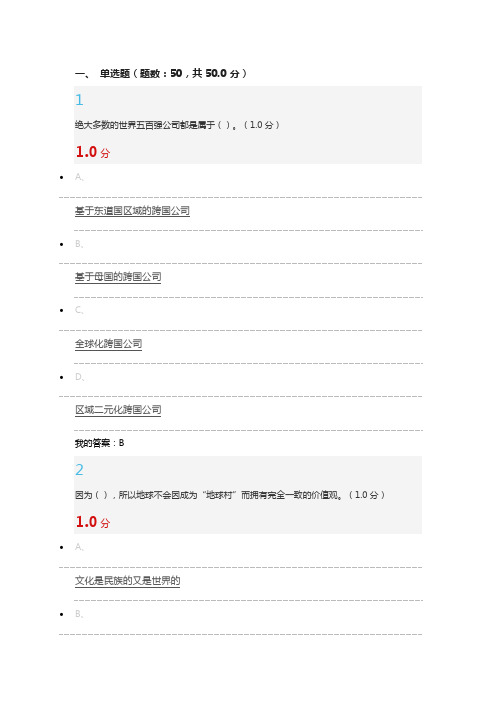
一、单选题(题数:50,共 50.0 分)1绝大多数的世界五百强公司都是属于()。
(1.0分)1.0分我的答案:B2因为(),所以地球不会因成为“地球村”而拥有完全一致的价值观。
(1.0分)1.0分我的答案:C3()生产的地砖、瓷砖是世界上质量最好的。
(1.0分)1.0分我的答案:B4下列选项中,日本人最看中的文化因素是()。
(1.0分)1.0分我的答案:D5当一个子公司面对高全球化压力,但是能力较低时,通常采取的战略选择是()。
(1.0分)1.0分我的答案:D6跨国公司的法律形式有哪四类?()(1.0分)1.0分我的答案:A7()是跨国公司内部交易的特征。
(1.0分)1.0分我的答案:B8关于跨国公司在大宗贸易市场竞争中的地位,下列说法错误的是()。
(1.0分)1.0分我的答案:B9关贸总协定的主要受益国是()。
(1.0分)0.0分我的答案:B10下列选项中,在美国价值观里排列第一位的是()。
(1.0分)1.0分我的答案:A11转移核心竞争力的战略是属于如下哪种国际竞争战略?()(1.0分)1.0分我的答案:D12()是IBM公司的亚太总部所在地。
(1.0分)1.0分我的答案:A13()是市场调查中的抽样对象。
(1.0分)1.0分我的答案:D14()是跨国公司制定国际化战略的主要目的。
(1.0分)1.0分我的答案:A15()是人类学最根本的研究方法。
(1.0分)1.0分我的答案:B16管理职能包括计划、组织、领导、()四大基本职能。
(1.0分)1.0分我的答案:B17下列选项中,非关税贸易壁垒不包括()。
(1.0分)1.0分我的答案:D18预期2006年到2020年,()是对全球经济增长贡献最大的国家。
(1.0分)1.0分我的答案:B19()是象征性交货,指卖方的交货义务。
(1.0分)1.0分我的答案:D20目前,国际汇率制度的格局是()。
(1.0分)1.0分我的答案:B21()是全球范围进行资源配置的方式。
电子商务基础与实务(国际商务)期末测试
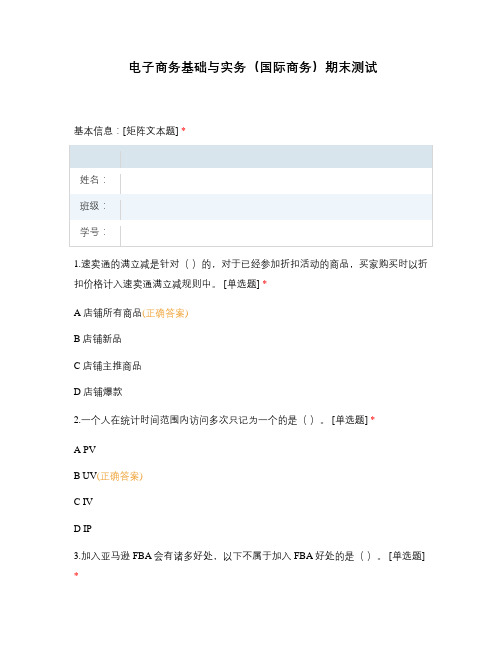
电子商务基础与实务(国际商务)期末测试基本信息:[矩阵文本题] *1.速卖通的满立减是针对()的,对于已经参加折扣活动的商品,买家购买时以折扣价格计入速卖通满立减规则中。
[单选题] *A 店铺所有商品(正确答案)B 店铺新品C 店铺主推商品D 店铺爆款2.一个人在统计时间范围内访问多次只记为一个的是()。
[单选题] *A PVB UV(正确答案)C IVD IP3.加入亚马逊FBA会有诸多好处,以下不属于加入FBA好处的是()。
[单选题] *A 提高商品的曝光度和竞争力B 有资格向消费者提供prime配送服务C 能够增加卖家获得buy box的几率D 能够使用特瞬送服务(正确答案)4.商品标题由关键词组成,关键词主要包括核心词、类目词、属性词以及长尾词四种类型。
其中长尾词是指()。
[单选题] *A 商品名称B 商品类目C 商品属性D 对组合词的修饰(正确答案)5.店铺或品牌运营人员通过后台数据分析,可以实时监控到未付款订单,运营人员可以与客服主管沟通,安排客服人员及时处理,以下不属于订单催付的原则的是()。
[单选题] *A 有已付款客户的订单不要催B 不要强行催付C 注意频率,不要重复催付D 要给客户承诺(正确答案)6.亚马逊评价体系中()的好坏,可以直接影响到该条Listing的曝光和排名。
[单选题] *A FeedbackB Review(正确答案)C DSRD ODR7.RFM模型是衡量客户价值和客户创利能力的重要工具和手段,该模型通过3项指标来描述客户的价值状况,以下不属于RFM指标内容的是()。
[单选题] *A 最近一次消费B 消费次数(正确答案)C 消费金额D 消费频率8.通过买家人传人的形式快速给店铺带来新流量,买家只有邀请其他买家帮忙才能领取的店铺优惠券是()。
[单选题] *A 领取型优惠券B 定向发放型优惠券C 聚人气优惠券(正确答案)D 秒抢优惠券9.商品上下架时间原理,是指商品在上架后需要选择()的重复下架和上架周期。
国际商务测试题与参考答案
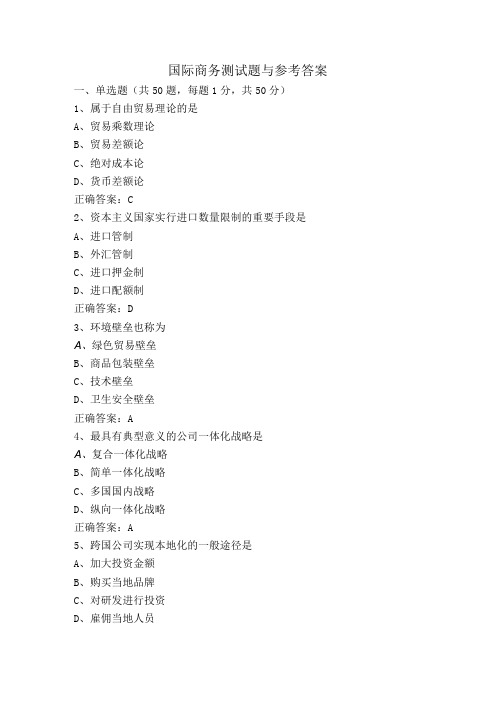
国际商务测试题与参考答案一、单选题(共50题,每题1分,共50分)1、属于自由贸易理论的是A、贸易乘数理论B、贸易差额论C、绝对成本论D、货币差额论正确答案:C2、资本主义国家实行进口数量限制的重要手段是A、进口管制B、外汇管制C、进口押金制D、进口配额制正确答案:D3、环境壁垒也称为A、绿色贸易壁垒B、商品包装壁垒C、技术壁垒D、卫生安全壁垒正确答案:A4、最具有典型意义的公司一体化战略是A、复合一体化战略B、简单一体化战略C、多国国内战略D、纵向一体化战略正确答案:A5、跨国公司实现本地化的一般途径是A、加大投资金额B、购买当地品牌C、对研发进行投资D、雇佣当地人员正确答案:C6、杠杆收购于20世纪60年代出现于A、美国B、日本C、英国D、法国正确答案:A7、国际商务谈判中谈判双方互相了解和收集情报的阶段是A、分析阶段B、策划阶段C、讨论阶段D、实施阶段正确答案:A8、投资动因是降低产品成本、追求竞争优势和更多的利润,这种跨国直接投资导向是A、低成本导向型B、先进技术导向型C、市场导向型D、自然资源导向型正确答案:A9、独家许可、从属许可和混合许可都属于A、独占许可B、中性许可C、普通许可D、交叉许可正确答案:B10、国际商务合作双方实质性接触的开始是A^还盘B、发盘C、签约D、询盘正确答案:D11、跨国公司转移利润的主要表现是A、转移产品B、调节价格C、转移成本D、合理避税正确答案:D12、现代的租赁贸易起源于A、法国B、美国C、日本D、英国正确答案:B13、在历史上第一次从生产领域出发,说明国际贸易发生与发展必然性的理论是A、绝对成本论B、比较成本论C、重商主义D、要素禀赋说正确答案:A14、世界贸易组织成员如有争端,应先行协商,在一方提出要求后必须开始协商的时限为A、60B、120C、90D、30正确答案:D15、商品生产国与商品消费国通过第三国进行的贸易,对第三国而言是A、过境贸易B、转口贸易C、直接贸易Ds多边贸易正确答案:B16、目前对跨国公司及直接投资影响最大的一种理论是A、垄断优势理论B、国际生产折衷理论C、竞争优势理论D、产品周期理论正确答案:B17、在国际商务谈判中,接受和发盘一样A、只属于法律行为B、只属于商业行为C、只属于交易行为D、既属于商业行为,也属于法律行为正确答案:D18、将取之于对外贸易中的货币仅作为财富珍藏下来,而不再投入对外贸易流通的理论称之为A、贸易平衡论B、贸易差额论C、贸易乘数理论D、货币差额论正确答案:D19、对于实行商品倾销的进口商品所征收的进口附加税是A、反倾销税B、差价税C、特惠税D、反补贴税正确答案:A20、普惠制的主要原则不包括A、特殊的B、非互惠的C、普遍的D、非歧视的正确答案:A21、我国海关正式采用《商品名称及编码协调制度》(HS)的时间是A、1996B、1992C、1994D、1993正确答案:B22、仅适用于海运和内河运输的国际贸易术语是A、FOB、FCC、CPTD、CIP正确答案:A23、在第一次世界大战与第二次世界大战之间盛行的贸易保护政策是A、早期重商主义B、新贸易保护主义C、晚期重商主义D、超保护贸易主义正确答案:D24、大卫•李嘉图的代表作是A、《国富论》B、《英国得自对外贸易的财富》C、《政治经济学及赋税原理》D、《就业、利息和货币通论》正确答案:C25、一国政府在一定时期以内,对某些商品的进口数量或金额加以直接的限制称为A、“自动”出口限制B、进口许可证制C、进口配额制D、进口押金制正确答案:C26、征税引起的进口量的变化称为A、消费效应B、生产效应C、贸易效应D、财政产应正确答案:C27、当今世界最大的服务贸易国是A^英国B、法国C、日本D、美国正确答案:D28、在租赁贸易中,连接货物的生产者和使用者的纽带是A、供货人B、出资人C、出租人D>承租人正确答案:C29、世界各国(地区)之间货物和服务交换的活动称为A、出口贸易B、进出口贸易C、进口贸易D、国际贸易正确答案:D30、凯恩斯的代表作是A、《政治经济学及赋税原理》B、《国富论》C、《就业、利息和货币通论》D、《政治经济学的国民体系》正确答案:C31、属于国际投资硬环境因素的是A^劳工素质B、管理水平C、社会文化D、自然资源正确答案:D32、货物的有关保险手续应当由卖方负责办理的国际贸易术语是B、FOC、CID、CPT正确答案:C33、一般代理又称A、佣金代理B、协议代理C、合同代理D、独家代理正确答案:A34、国际服务活动中最主要的方式是A、过境交付B、境外消费C、自然人流动D、商业存在正确答案:D35、1974年美国在其贸易法第301条款中首次使用的概念是A、世界贸易组织B、世界服务贸易C^跨国公司D、经济全球化正确答案:B36、为证明增加新投资对就业和国民收入的好处,凯恩斯提出了A、投资乘数理论B、偏好相似理论C、比较成本理论D、绝对成本理论正确答案:A37、世界贸易组织建立的时间是A、2001C、1993D、1991正确答案:B38、企业并购属于跨国直接投资的A、股权安排方式B、非股权安排方式C、BOTD、TOT正确答案:A39、产品周期理论的首创者是A、波特B、海默C、邓宁D、维农正确答案:D40、在19世纪初就被广泛采用的贸易术语是A、FOB、CFRC、CID、FCA正确答案:A41、推动经济全球化的主体是Λ^跨国公司B、国际货币基金组织C、世界银行D、世界贸易组织正确答案:A42、跨国生产本地化不包括A、人员本地化B、利润本地化C、管理本地化D、生产本地化正确答案:A43、跨国公司实现规模经济、提高全球生产效率的最基本条件是A、对员工进行东道国语言培训B、使员工适应东道国的文化C、产品及其生产过程的标准化D、给予员工有竞争力的报酬正确答案:C44、国际投资环境的特点不包括A、综合性B、动态性C、系统性D、安全性正确答案:D45、资本主义早期的国际贸易理论是A、重商主义B、凯恩斯主义C、重农主义D、超保护贸易主义正确答案:A46、普通许可又称A、交叉许可B、一般许可C、中性许可D、从属许可正确答案:B47、关税按照其保护的程度和有效性分类可分为A、财政关税和保护关税B、名义关税和有效关税C、进口附加税、差价税和特惠税D、进口税、出口税和过境税正确答案:B48、最先采用投资环境分析法的美国经济学家是A、伊西•利特瓦克B、彼得•拜廷C、罗伯特•斯托鲍夫D、威德尔希姆•保罗正确答案:C49、从世界经济相互联接的紧密性上说,世界经济一体化发展中最深刻的表现形式是A、跨国公司B、世界银行C、关贸总协定D、国际货币基金组织正确答案:A50、收购公司并不向目标公司直接提出购并的要求,而是通过在市场上收购目标公司已发行和流通的具有表决权的普通股票,从而取得目标公司控制权的行为称为A、协议收购B、友好接管C、直接并购D、间接并购正确答案:D二、多选题(共50题,每题1分,共50分)k IS014000系列标准是一套一体化的国际标准,包括A、环境标志B、环境绩效评价C、环境管理体系D、产品生命周期评价E、环境审核正确答案:ABCDE2、属于贸易保护理论的有A、贸易乘数理论B、货币差额论C、贸易差额论D、绝对成本论E、比较成本论正确答案:ABC3、属于直接非关税壁垒的有A、“自动”出口限制B、最低限价制C、进口许可证制D、进口配额制E、进口押金制正确答案:ACD4、补偿贸易的做法有A、直接产品补偿法B、技术补偿法C、劳务补偿法D、加工补偿法E、间接产品补偿法正确答案:ACE5、反倾销法限制的倾销有A、产品倾销B、运费倾销C、服务倾销D、社会倾销E、间接倾销正确答案:ADE6、跨国公司一体化战略的类型有A、复合一体化战略B、简单一体化战略C、多国国内战略D、纵向一体化战略E、横向一体化战略正确答案:ABC7、自由贸易理论的代表人物有A、俄林B、大卫・李嘉图C、赫克歇尔D、托马斯•孟E、亚当•斯密正确答案:ABCE8、适用于各种运输方式的国际贸易术语有A、CIPB、CFRC、CID、FCE、CPT正确答案:ADE9、属于间接非关税壁垒的有A、进口许可证制B、最低限价制C、海关估价制D、“自动”出口限制E、进口押金制正确答案:BCE10、商品采购中的招标投标业务的基本步骤有A、履行和约B、签订合约C、招标D、投标E、开标和评标正确答案:BCDE11、影响跨国公司经营的各种文化要素有A、行为方式与习惯B、宗教C、审美D、教育E、语言正确答案:ABCDE12、国际服务贸易的表现形式主要有A、商业存在B、境外消费C、境内消费D、过境交付E、自然人流动正确答案:ABDE13、国际商务谈判人员应具备的业务素质有A、精通外语B、心理素质C、市场经验D、有驻外经历E、专业知识正确答案:BCE14、撰写可行性研究报告需要较规范的内容,主要包括A、产业政策B、定价策略C^需求分析D、市场进入方案E、市场分析正确答案:ABCDE15、属于国际投资硬环境因素的有A、劳工素质B、能源供应C、基础设施D、政治稳定性E、自然资源正确答案:BCE16、国际生产折衷理论提出的决定一国企业对外直接投资的变量有A、所有权优势B、内部化优势C、区位优势D、技术优势E、资金优势正确答案:ABC17、跨国公司转移利润的主要表现有A、调节价格B、利润调节C、转移成本D、合理避税E、转移资金正确答案:BDE18、在两届部长会议之间,负责处理世界贸易组织日常工作的有A、总理事会B、贸易政策审议机构C、分理事会D、争端解决机构E、专门委员会正确答案:ABD19、目前在国际上受到跨国公司关注的人力资源管理战略主要有A、东道国语言培训B、适应东道国的文化C、帮助员工移民海外D、帮助员工子女在海外学习E、给予员工有竞争力的报酬正确答案:ABE20、美国麻省理工学院著名教授罗宾逊根据企业管理结构的演变及其在国外销售额增长情况,将处于不同发展阶段的企业主要分成A、出口型公司B、国际公司C、多国公司D、跨国公司E、内向型公司正确答案:ABCDE21、波特认为一个国家的内部竞争环境的形成因素有A、需求状况B、要素禀赋C、相关产业和辅助产业D、公司的策略、结构和竞争E、供给状况正确答案:ABCD22、关税的国内效应包括A、财政效应B、消费效应C、生产效应D、贸易效应E、再分配效应正确答案:ABCDE23、从收购者与被收购者的关系上来看,跨国公司对外国企业的收购可以分为A、纵向型收购B、横向型收购C、集中型收购D、混合型收购E、全部收购正确答案:ABCD24、不属于反倾销法调整范围的倾销有A、外汇倾销B、产品倾销C、运费倾销D、社会倾销E、服务倾销正确答案:ACE25、国际技术许可根据许可人和被许可人权利义务关系,可分为A、交叉许可B、中性许可C、特定许可D、独占许可E、普通许可正确答案:ABDE26、普惠制的主要原则有A、非互惠的B、非歧视的C、普遍的D、互惠的E、歧视的正确答案:ABC27、货物的风险在其越过船舷后由卖方转移至买方的国际贸易术语有A、FOB、CFRC、CID、FCE、CPT正确答案:ABC28、属于国际投资软环境因素的有A、自然资源B、社会文化C、劳工素质D、管理水平E、政治稳定性正确答案:BCDE29、企业并购的基本方法有A、许可证合同B、股票收购C、资产收购D、杠杆收购E、现金收购正确答案:BDE30、国际投资的环境因素有A、政治环境B、经济环境C、法律环境D、自然环境E、文化环境正确答案:ABCDE31、国际技术贸易一般是技术商品使用权的转让,主要包括A、肖像使用权B、商标使用权C、专有技术使用权D、著作使用权E、专利使用权正确答案:BCE32、中国环境保护的制度有A、限期治理B、环境影响评价C、污染集中控制D、排污许可证E、排污收费正确答案:ABCDE33、技术是一种无形资产,按变化程度可分为A、原有技术B、新技术C、落后技术D、改进技术E、先进技术正确答案:ABD34、跨国公司采取并购的方式进行投资的动机有A、地区多元化B、获取特定的技术C、产品多样化D、资金多元化E、进行生产正确答案:ABCDE35、国际货物买卖和服务贸易中的代理按委托人的授权分为A、合同代理B、协议代理C、一般代理D、总代理E、独家代理正确答案:CDE36、国际独资企业的形式主要有A、国外避税地公司Bs国外子公司C、国外合资公司D、国外公司集团E、国外分公司正确答案:ABE37、关税税收筹划的方法通常有A、利用保税制度B、利用税法漏洞C、利用纳税时间D、利用优惠政策E、利用完税价格正确答案:ACDE38、关税按照征税的一般方法或征税标准分类可分为A、从量税B、附加税C、选择税D、从价税E、混合税正确答案:ACDE39、技术是一种无形资产,按先进程度可分为A、原有技术B、中间技术C、新技术D、先进技术E、落后技术正确答案:BDE40、世贸组织总理事会下设的分理事会有A、与贸易有关的知识产权理事会B、技术贸易理事会C、服务贸易理事会D、国际投资理事会E、货物贸易理事会正确答案:ACE41、中国环境保护的政策有A、污染集中控制B、排污收费C、预防为主D、谁污染谁治理E、强化管理正确答案:CDE42、古典自由贸易理论有A、货币差额论B、要素禀赋说C、比较成本论D、贸易差额论E、绝对成本论正确答案:CE43、许可证贸易的标的有A^工业设计B、专有技术C、商标D、商业咨询E、专利正确答案:ABCE44、撰写可行性研究报告的目的有A、给投资者决策提供依据B、为银行贷款提供依据C、为同合作者签约提供依据D、为跨国经营和防范风险提供依据E、为工程设计提供依据正确答案:ABCDE45、属于中性许可的有A、相互许可B、独家许可C、从属许可Ds混合许可E、交叉许可正确答案:BCD46、属于自然人流动的有A、出国留学B、境外投资建厂C、境外讲学D、境外务工E、国外就医正确答案:CD47、仅适用于海运和内河运输的国际贸易术语有A、FOB、CFRC、CID、FCE、CPT正确答案:ABC48、经济特区的类型有A、自由边境区B、出口加工区C、保税区D、科学工业园区E、自由港正确答案:ABCDE49、贸易保护理论的代表人物有A、博丹B、孟克列钦C、柯尔培尔D、斯塔福德E、托马斯•孟正确答案:ABCDE50、跨文化培训一般包括A、现场体验B、语言训练C、文化介绍D、敏感性训练E、环境介绍正确答案:ABCDE。
国际商务管理期末考试复习题

国际商务管理期末考试复习题1、跨国公司的经营特征:全球战略目标、全球一体化经营、灵活多样的经营策略、强大的技术创新能力、具有较大的经营风险2、国际生产折衷理论基本观点:核心是,企业跨国经营是该企业具有的所有权特定优势、内部化优势和区位优势综合作用的结果。
3、国际商务的宏观环境:4、制度与市场环境、政治与法律环境、经济和技术环境、社会文化环境5、区域经济一体化依据其经济结合程度和相互依存关系,可分为:自由贸易区、关税同盟、共同市场、经济联盟和完全经济一体化。
6、国际商务经营形式:(1)出口:①间接出口②直接出口(2)非股权安排:①技术授权②其他非股权安排形式(3)股权投资形式,它主要是指对外直接投资7、跨国并购的方式:股票替换、债券互换、现金收购、以及这三种方式的综合使用。
8、跨国公司组织结构的变化趋势(1)扁平化,由传统的金字塔形象扁平化发展是当前企业组织结构变革的主要形式。
(2)跨国公司地区总部,是指跨国公司为更好实现其全球经营战略目标,在区域内某东道国设立一个区域型管理机构。
(3)网络化,随着经济全球化的发展和互联网技术在国际经营活动中的广泛应用,西方一些大型跨国公司的组织结构开始向网络化发展。
(4)学习型组织,是指能熟练地创造、获取和传递知识,同时也善于修正自身的行为,以适应新的知识和见解的组织。
9、国际分销渠道策略(1)直接渠道与间接渠道策略(2)渠道长度策略(3)渠道宽度策略10、国际技术转移的方式(1)国际商品贸易(2)国际技术许可(3)国际许可经营(4)国际技术咨询与服务(5)技术所有权转移(6)与国际工程承包、国际合作生产和国外直接投资相结合的技术转移11、国际人力资源管理的国际策略:名族中心策略、多中心策略、全球中心策略、混合策略12、中国企业国际化经营战略分析(1)经营主体:第一,专业外贸公司和大型贸易集团。
第二,大型生产型企业或企业集团。
第三,大型服务企业与银行或其他非银行金融企业。
2017年全国国际商务单证员专业考试国际商务单证基础理论与知识试题(附答案)

2017年全国外经贸单证专业培训考试单证基础理论与知识试题(考试时间:11月26日下午13﹕00—15﹕00)一、单项选择题(总共80小题,每小题0.5分,共40分。
单项选择题的答案只能选择一个,多选不得分,请在答题卡上将相应的选项涂黑)1.《URC522》根据国际贸易单证的性质将单据分为()。
A.基本单据和附属单据B.金融单据和商业单据C.进口单据和出口单据D.纸质单据和电子单据2.根据《INCOTERMS 2010》下列贸易术语中装货费和卸货费都由卖方承担的是()。
A.CIF B.DATC.FOB D.DAP3.缮制各种进出口单证时,原则上应该做到()。
A.完整、及时、无差错B.完整、简洁、清晰C.及时、正确、完整、简洁、清晰D.正确、完整、及时、简明、整洁4.《INCOTERMS 2010》中,以下哪种术语仅适用于海运和内河水运的术语()。
A.FAS B.FCAC.CIP D.DAP5.根据联合国设计推荐使用的国际标准化货币代码,中国、美国、欧盟货币的正确表述是()。
A.RMB/USD/EUR B.CNY/USD/UERC.CNY/USD/EUR D.CNY/UDS/EUR6.各种运输单据中,能同时具有货物收据、运输合同证明和物权凭证作用的是()。
A.铁路运单B.航空运单C.海运提单D.海运单7.贸易术语又称(),其表现形式为三字母英文代码,其含义是用来说明价格的构成,以及买卖双方在交接货物过程中各自承担的责任、风险、手续和费用的划分。
A.贸易方式B.价格术语C.《INCOTERMS 2010》D.《华沙—牛津规则》8.根据《2010年国际贸易术语解释通则》,若以CFR条件成交,买卖双方风险划分是以()为界。
A.货物交给承运人保管B.货物交给第一承运人保管C.货物在装运港置于船上D.货物在目的港越过船舷9.()是一种不使用汇票的远期信用证。
A.承兑信用证B.议付信用证C.延期付款信用证D.即期付款信用证10.信用证规定装运期限为2016年8月份,有效期为9月15日,没有规定交单期。
国际商务入门期末考试题及答案
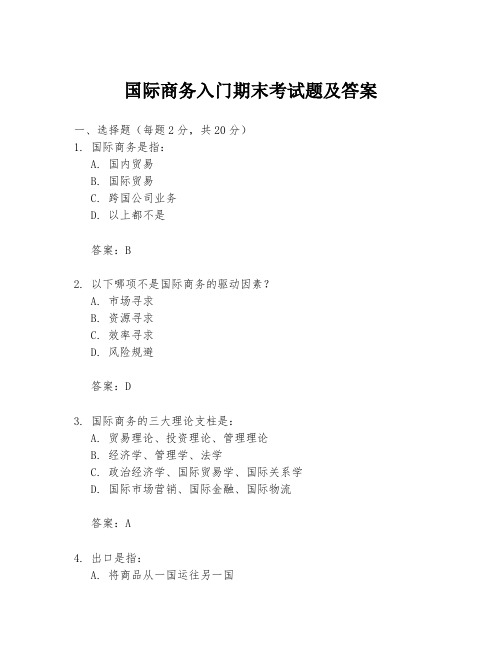
国际商务入门期末考试题及答案一、选择题(每题2分,共20分)1. 国际商务是指:A. 国内贸易B. 国际贸易C. 跨国公司业务D. 以上都不是答案:B2. 以下哪项不是国际商务的驱动因素?A. 市场寻求B. 资源寻求C. 效率寻求D. 风险规避答案:D3. 国际商务的三大理论支柱是:A. 贸易理论、投资理论、管理理论B. 经济学、管理学、法学C. 政治经济学、国际贸易学、国际关系学D. 国际市场营销、国际金融、国际物流答案:A4. 出口是指:A. 将商品从一国运往另一国B. 将服务从一国提供给另一国C. 将资本从一国转移到另一国D. 将信息从一国传递到另一国答案:A5. 以下哪个不是国际商务中的贸易壁垒?A. 关税壁垒B. 配额壁垒C. 技术壁垒D. 价格壁垒答案:D6. 国际商务中的“文化”指的是:A. 艺术和文学B. 语言和习俗C. 政治和经济D. 宗教和哲学答案:B7. 跨国公司的总部通常设在:A. 资源丰富的国家B. 市场潜力大的国家C. 劳动力成本低廉的国家D. 政治稳定的国家答案:B8. 国际商务中的“全球化”是指:A. 世界经济一体化B. 世界政治一体化C. 世界文化一体化D. 世界社会一体化答案:A9. 国际商务中的风险包括:A. 政治风险B. 经济风险C. 法律风险D. 所有以上答案:D10. 国际商务谈判中,以下哪项不是常见的谈判策略?A. 让步策略B. 拖延策略C. 合作策略D. 强制策略答案:D二、简答题(每题10分,共30分)11. 简述国际商务的三个主要特点。
答案:国际商务的三个主要特点是跨国性、多样性和复杂性。
跨国性指的是商务活动跨越国界,涉及不同国家和文化;多样性指的是国际商务涉及多种不同的市场、产品和业务模式;复杂性则是指国际商务活动受到多种因素的影响,如政治、经济、法律和文化等。
12. 解释什么是“比较优势”理论,并给出一个例子。
答案:比较优势理论是由大卫·李嘉图提出的,它认为即使一个国家在所有生产领域都不比其他国家更有效率,它仍然可以专注于生产自己相对效率最高的商品,并通过贸易来获取其他商品,从而实现资源的最优配置。
国际商务英语试题及答案

国际商务英语试题及答案一、选择题(每题2分,共20分)1. The term "FOB" in international trade refers to:A. Free on BoardB. Free of BoardC. Full of BoardD. Final on Board答案:A2. Which of the following is not a document required for exporting goods?A. Commercial InvoiceB. Packing ListC. Certificate of OriginD. Birth Certificate答案:D3. In international business, what does "T/T" stand for?A. Trust TransferB. Telex TransferC. Transfer TrustD. Telegraphic Transfer答案:D4. The most common method of payment in international trade is:A. Cash in AdvanceB. Letter of CreditC. ConsignmentD. Countertrade答案:B5. What is the meaning of "CIF" in international trade terms?A. Cost, Insurance, and FreightB. Cost, Insurance, and Freight to DestinationC. Cost, Insurance, Freight, and CommissionD. Cost, Insurance, Freight, and Taxes答案:A6. Which of the following is not a function of a commercial bank in international business?A. Letter of Credit IssuanceB. Foreign Exchange ServicesC. Insurance ServicesD. Documentary Collections答案:C7. The Incoterms rule that requires the seller to arrange for carriage but not insurance is:A. FOBB. CFRC. CIFD. CIP答案:B8. What is the abbreviation for "World Trade Organization"?A. WTOB. WBOC. WTOOD. WOT答案:A9. In international trade, the term "D/P" stands for:A. Documents against PaymentB. Direct PaymentC. Direct PurchaseD. Deferred Payment答案:A10. The document that proves the ownership of goods being transported is:A. Bill of LadingB. Air WaybillC. Sea WaybillD. Railway Bill答案:A二、填空题(每题2分,共20分)1. The ________ is an international treaty that governs the rules of international trade.答案:GATT2. When goods are sold on a ________ basis, the seller retains the title until payment is made.答案:Consignment3. The ________ is a type of documentary credit that allows the seller to draw the money before shipment.答案:Usance Letter of Credit4. In international trade, the ________ is the document that proves the goods have been loaded on board the vessel.答案:Bill of Lading5. The ________ is a document that lists the contents and details of each package in a shipment.答案:Packing List6. The ________ is a document that provides information about the origin of the goods.答案:Certificate of Origin7. The ________ is a document that shows the terms and conditions of a sale.答案:Sales Contract8. The ________ is a document that provides proof of insurance coverage for the goods being transported.答案:Insurance Policy9. The ________ is a document that lists the goods and their quantities, weights, and measures.答案:Manifest10. The ________ is a document that provides a summary of the financial transactions between the buyer and seller.答案:Statement of Accounts三、简答题(每题10分,共40分)1. Explain the difference between a "Proforma Invoice" and a "Commercial Invoice".答案:A Proforma Invoice is a document that serves as a preliminary invoice providing details about the shipment andis often used for customs purposes or as a reference for the buyer. A Commercial Invoice, on the other hand, is a legally binding document that outlines the terms of sale, includingthe price, quantity, and description of goods, and is usedfor customs clearance and payment purposes.2. What are the advantages and disadvantages of using aLetter of Credit in international trade?答案:Advantages include security for both the buyer and seller, as the payment is guaranteed by a bank, and itprovides a framework for the transaction. Disadvantagesinclude the cost of the bank fees, potential delays due to documentation issues, and the complexity of the process.3. Describe the process of a Documentary Collection in international trade.答案:In a Documentary Collection, the exporter ships the goods and submits the required documents to their bank, which then forwards them to the importer's bank. The importer'sbank releases the documents to the importer upon payment (D/P) or acceptance of a time draft (D/A).4. What is the role of a freight forwarder in international trade?答案:A freight forwarder acts as an intermediary between the exporter and various transportation services, arranging forthe transportation of goods, preparing necessary documents,。
国际商务管理期末考试答案
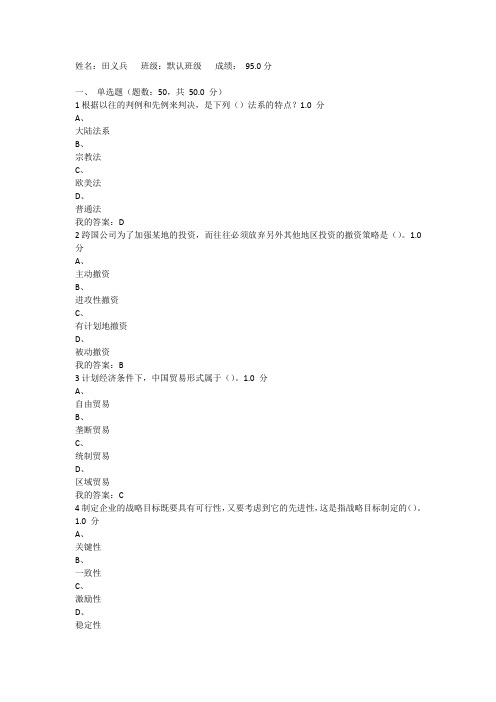
姓名:田义兵班级:默认班级成绩:95.0分一、单选题(题数:50,共50.0 分)1根据以往的判例和先例来判决,是下列()法系的特点?1.0 分A、大陆法系B、宗教法C、欧美法D、普通法我的答案:D2跨国公司为了加强某地的投资,而往往必须放弃另外其他地区投资的撤资策略是()。
1.0 分A、主动撤资B、进攻性撤资C、有计划地撤资D、被动撤资我的答案:B3计划经济条件下,中国贸易形式属于()。
1.0 分A、自由贸易B、垄断贸易C、统制贸易D、区域贸易我的答案:C4制定企业的战略目标既要具有可行性,又要考虑到它的先进性,这是指战略目标制定的()。
1.0 分A、关键性B、一致性C、激励性D、稳定性我的答案:C5下列不属于政治风险的是()。
0.0 分A、本国化B、国有化C、当地化D、有偿征用我的答案:D6当前我国外汇储备中最主要的是()。
1.0 分A、欧元B、日元C、黄金D、美元我的答案:D7根据要素禀赋论,下列不适宜发展资本密集型产业的国家是()。
1.0 分A、美国B、日本C、澳大利亚D、朝鲜我的答案:D8差异化战略的核心是取得某种对顾客有价值的()。
1.0 分A、可靠性B、信誉性C、实用性D、独特性我的答案:D9按照一般跨国公司组织形式发展的第三阶段是()。
1.0 分A、销售部B、出口部C、国际部D、全球结构我的答案:C10下列要素中,不属于国家竞争优势钻石模型中基本要素的是()。
1.0 分A、自然地理环境B、人口C、通讯基础D、气候我的答案:C11出口补贴作为一种鼓励出口的措施就是在出口某种商品时给予出口商()优惠待遇。
1.0 分A、仅在退还进口税上B、仅在财政上C、仅在现金补贴上D、在现金补贴或财政上我的答案:D12全球化发展的物质基础是()。
1.0 分A、跨国公司的经营成果B、新技术革命提供的成果C、全球性的非管制化和市场化政策D、国际金融市场的深化与创新我的答案:B13重商主义理论盛行于()。
国际商务期末试题及答案
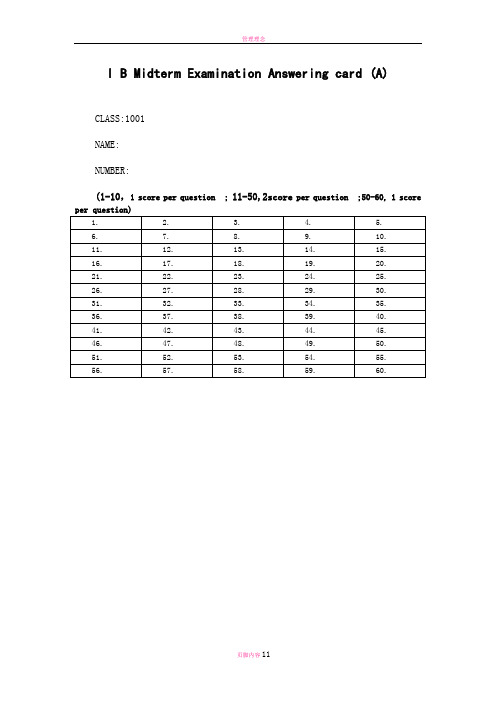
I B Midterm Examination Answering card (A)CLASS:1001NAME:NUMBER:(1-10,1 score per question ;11-50,2score per question ;50-60, 1 scoreI. True / False Questions (1 score per question)1.The notion that national economies are relatively self-contained entities is on the rise.2.Mercantilism advocated that countries should encourage exports and imports.3. A firm becomes a multinational enterprise when it undertakes foreign direct investment.4.The two most common methods of restricting inward FDI are ownership restraints and performance requirements.5. The most global markets currently are markets for industrial goods and materials that serve a universal need the world over.6. Outsourcing is a process that is limited to manufacturing enterprises.7. According to Porter, four broad attributes of a nation shape the environment in which local firms compete including supply conditions, factor endowments, regulation, and advanced factors.8. One of the UN central mandates is the promotion of higher standards of living, full employment, and conditions of economic and social progress and development9. The total amount of capital invested in factories, stores, office buildings and the like is referred to as the stock of FDI.10. Licensing involves the establishment of a new operation in a foreign country.II. Multiple Choice Questions(11-50,2score per question ; 51-60, 1 score per question)11.Which of the following is not characteristic of globalization?A. National economies are turning into independent economic systems.B. Material culture is starting to look similar the world over.C. Perceived distance is shrinking due to advances in transportation and telecommunications.D. Barriers to cross-border trade and investment are declining.12.Which of the following is not an impediment(限制) that makes it difficult for firms to achieve the optimal dispersion(最优分散)of their productive activities to locations around the globe?A. Reduced transportation costs.B. Government regulations.C. Issues associated with economic and political risk.D.Barriers to foreign direct investment.13.Technological innovations have facilitated all of the following except:A. globalization of production.B. globalization of markets.C. creation of electronic global marketplaces.D. creation of absolutely homogeneous(均匀的) consumer markets.14.What is the total cumulative value of foreign investments best referred to as?A. Accumulation of foreign sharesB. Portfolio investmentsC. Stock of foreign direct investmentsD.Stock market investments15.If the critics of globalization are correct, all of the following things must be shown except:A. the share of national income received by labor, as opposed to the share received by the owners of capital should have declined in advanced nations.B. even though labor's share of the economic pie may have declined, living standards need not deteriorate if the size of the total pie has increased sufficiently to offset(抵消) the decline in labor's share.C. the decline in labor's share of national income must be due to moving production to low-wage countries, as opposed to improving production technology and productivity.D.economic growth in developed nations has offset the fall in unskilled workers' share of national income, raising their living standards.16.This theory, advanced by the 19th-century English economist David Ricardo, forms the intellectual basis of the modern argument for unrestricted free trade.A. Heckscher-OhlinB. MercantilismC. Comparative advantageD. Absolute advantage17.This theory explains the observed patterns of international trade by emphasizing the interplay between the proportions in which the factors of production are available in different countries and the proportions in which they are needed for producing particular goods.A. MercantilismB. Heckscher-OhlinC. Absolute advantageparative advantage18.Identify the incorrect statement pertaining to Raymond Vernon's product life-cycle theory.A. Early in their life cycle, most new products are produced in and exported from the country in which they were developed.B. As a new product becomes widely accepted internationally, production startsin other countries.C. A product in the early stage of the product life-cycle is imported by the country where it was innovated.D. A product may ultimately be exported back to the country of its original innovation.19.The theory of _____, developed by Michael Porter, focuses on the importance of country factors, in addition to factor endowments, such as domestic demand and domestic rivalry in explaining a nation's dominance in the production and export of particular products.A. new tradeB. absolute advantageC. comparative advantageD. national competitive advantage20.Identify the theory that can be interpreted as justifying some limited government intervention to support the development of certain export-oriented industries.A. Theory of national competitive advantageB. Heckscher-Ohlin theoryC. Theory of comparative advantageD.Theory of absolute advantage21.Mercantilism viewed trade as a(n):A. economic evil.B. zero-sum game.C. nonessential economic activity.D. threat to a government's independence.22.What is the basic message of the theory of comparative advantage?A. Countries are similar in their ability to produce goods efficientlyB. International trade is rarely beneficial to a countryC. Potential world production is greater with unrestricted free trade than it is with restricted tradeD. Trade is a zero-sum game23.According to the product life-cycle theory, the locus of global production initially switches from the U.S. to other advanced nations and then from those nations to developing countries. The consequence of this trend for the pattern of world trade is that over time the U.S.:A. becomes the sole producer of the product.B. switches from being an exporter of the product to being an importer of the product.C. switches from being an importer of the product to being an exporter of theproduct.D. becomes the sole consumer of the product.24._____ suggests that when nations trade, each nation may be able to specialize in producing a narrower range of products than it would in the absence of trade, and through trade, each nation can simultaneously increase the variety of goods available to its consumers and lower the costs of those goods.A. The product life-cycle theoryB. Porter's diamond of competitive advantageC. New trade theoryD. The theory of comparative advantage25.According to the new trade theorists, because early entrants are able to gain _____, the early entrants into an industry may get a lock on the world market that discourages subsequent entry.A. zero-sum advantagesB. highly skilled employeesC. process expertiseD. economies of scale26. A greenfield investment:A. is a form of FDI that involves the establishment of a new operation in a foreign country.B. involves a 7 percent stock in an acquired foreign business entity.C. involves a merger with a foreign business.D. occurs when a firm acquires another company in a foreign country.27.Historically, most FDI has been directed at the _____ nations of the world as firms based in advanced countries invested in:A. underdeveloped; underdeveloped countries.B. developed; underdeveloped countries.C. developed; each other's markets.D. underdeveloped; each other's markets.28.Identify the incorrect statement regarding the direction of FDI.A. Historically, most FDI has been directed at the developing nations of the world.B. During the 1980s and 1990s, the United States was often the favorite target for FDI inflows.C. The developed nations of the EU have received significant FDI inflows.D. Recent inflows into developing nations have been targeted at the emerging economies of South, East, and Southeast Asia.29.According to Knickerbocker:A. the firms that pioneer a product in their home markets undertake FDI to produce a product for consumption in a foreign market.B. when a firm that is part of an oligopolistic industry expands into a foreign market, other firms in the industry will be compelled to make similar investments.C. combining location-specific assets or resource endowments and the firm's own unique assets often requires FDI.D. impediments to the sale of know-how increase the profitability of FDI relative to licensing.30.When two or more enterprises encounter each other in different regional markets, national markets, or industries, there is:A. vertical integration.B. horizontal integration.C. multipoint competition.D. monopolistic competition.31.The product life cycle suggests that:A. often the same firms that pioneer a product in their home markets undertake FDI to produce a product for consumption in foreign markets.B. when a firm that is part of an oligopolistic industry expands into a foreign market, other firms in the industry will be compelled to make similar investments.C. combining location-specific assets or resource endowments and the firm's own unique assets often requires FDI.D. impediments to the sale of know-how increase the profitability of FDI relative to licensing.32.The _____ suggests that a firm will establish production facilities where foreign assets or resource endowments that are important to the firm are located.A. product life cycleB. strategic behavior theoryC. multipoint competition theoryD. eclectic paradigm33.Advantages that arise from using resource endowments or assets that are tied to a particular location and that a firm finds valuable to combine with its own unique assets are known as:A. location-specific advantages.B. resource-specific advantages.C. competitive advantages.D. directional advantages.34.John Dunning, a champion of the eclectic paradigm, argues that:A. the firms that pioneer a product in their home markets undertake FDI to produce a product for consumption in a foreign market.B. when a firm that is part of an oligopolistic industry expands into a foreign market, other firms in the industry will be compelled to make similar investments.C. combining location-specific assets or resource endowments and the firm's own unique assets often requires FDI.D. impediments to the sale of know-how increase the profitability of FDIrelative to licensing.35.According to the _____ view of FDI, MNEs extract profits from the host country and take them to their home country, giving nothing of value to the host country in exchange.A. imperialistB. conservativeC. free marketD. radical36.Which of the following is not an impediment that makes it difficult for firms to achieve the optimal dispersion of their productive activities to locations around the globe?A. Reduced transportation costs.B. Government regulations.C. Issues associated with economic and political risk.D.Barriers to foreign direct investment.37.Michael Porter has argued that _____ and _____ are two basic strategies for creating value and attaining a competitive advantage in an industry.A. differentiation; price competitionB. economies of scale; diversification.C. low cost; differentiationD. efficiency; promotion38. The _____ was created in 1944 by 44 nations that met in Breton Woods, New Hampshire to promote economic development.A. World BankB. International Trade CenterC. World Trade OrganizationD. United Nations39. Identify the incorrect statement pertaining to the World Wide Web.A. It makes it much easier for buyers and sellers to find each other.B. Viewed globally, it is emerging as an equalizer.C. It rolls back all of the constraints of location, scale, and time zones.D.It allows businesses to expand their global presence at a lower cost than ever before.40. Technological innovations have facilitated all of the following except:A. globalization of production.B. globalization of markets.C. creation of electronic global marketplaces.D. creation of absolutely homogeneous consumer markets.41. What is the total cumulative value of foreign investments best referred to as?A. Accumulation of foreign sharesB. Portfolio investmentsC. Stock of foreign direct investmentsD. Stock market investments42. Identify the incorrect statement regarding the former Communist nations of Europe and Asia.A. The economies of most of the former Communist states are very strong and developed.B. Many of the former Communist nations of Europe and Asia share a commitment to free market economies.C. As a result of disturbing signs of growing unrest and totalitarian tendencies, the risks involved in doing business in these countries is very high.D. For about half a century these countries were essentially closed to Western international business.43.When a company "exports jobs" overseas, the company is:A. helping domestic workers by pushing up wage rates.B. increasing the demand of qualified domestic workers.C. taking advantage of lower wages in foreign markets.D. deceiving the supporters of globalization.44. Propagated in the 16th and 17th centuries, _____ advocated that countries should simultaneously encourage exports and discourage imports.A. ethnocentrismB. capitalismC. collectivismD. mercantilism45. Identify the incorrect statement pertaining to Raymond Vernon's product life-cycle theory.A. Early in their life cycle, most new products are produced in and exported from the country in which they were developed.B. As a new product becomes widely accepted internationally, production starts in other countries.C. A product in the early stage of the product life-cycle is imported by the country where it was innovated.D. A product may ultimately be exported back to the country of its original innovation.46. Identify the theory that can be interpreted as justifying some limited government intervention to support the development of certain export-oriented industries.A. Theory of national competitive advantageB. Heckscher-Ohlin theoryC. Theory of comparative advantageD. Theory of absolute advantage47. China, deliberately keeping its currency value low against the U.S. dollar in order to sell more goods to the United States, and thus amass a trade surplus and foreign exchange reserves, is viewed by critics as following a:A. zero-sum game.B. neo-mercantilist policy.C. positive-sum game.D. free trade policy.48. A basic tenet of Ricardo's theory is that:A. consumers in those countries with an absolute advantage in the production of all goods might derive no benefits from international trade.B. consumers in all nations can consume more if there are no restrictions on trade.C. restrictions on trade help consumers in countries that lack an absolute advantage in the production of a particular good.D. trade is a zero-sum game.49. According to the _____ model, when a rich country enters into a free trade agreement with a poor country that rapidly experiences dynamic gains, the rich country is likely to not have net gains.A. absolute advantageB. mercantilistC. Heckscher-OhlinD. Samuelson50. According to the new trade theorists, because early entrants are able to gain _____, the early entrants into an industry may get a lock on the world market that discourages subsequent entry.A. zero-sum advantagesB. highly skilled employeesC. process expertiseD. economies of scale51. A greenfield investment:A. is a form of FDI that involves the establishment of a new operation in a foreign country.B. involves a 7 percent stock in an acquired foreign business entity.C. involves a merger with a foreign business.D. occurs when a firm acquires another company in a foreign country.52. If General Electric, a U.S. based corporation, purchased a 50 percent interest in a company in Italy, that purchase would be an example of a(n):A. minority acquisition.B. outright stake.C. majority acquisition.D. greenfield investment.53. FDI has been rising for all of the following reasons except:A. the globalization of the world economy.B. the general increase in trade barriers over the past 30 years.C. firms are trying to circumvent trade barriers.D. there is a shift toward democratic political institutions and free market economies.54. Historically, most FDI has been directed at the _____ nations of the world as firms based in advanced countries invested in:A. underdeveloped; underdeveloped countries.B. developed; underdeveloped countries.C. developed; each other's markets.D. underdeveloped; each other's markets.55. Identify the incorrect statement regarding the direction of FDI.A. Historically, most FDI has been directed at the developing nations of the world.B. During the 1980s and 1990s, the United States was often the favorite target for FDI inflows.C. The developed nations of the EU have received significant FDI inflows.D.Recent inflows into developing nations have been targeted at the emerging economies of South, East, and Southeast Asia.56. The total amount of capital invested in factories, stores, office buildings, and the like is summarized by:A. gross fixed capital formation.B. total investment capital.C. total tangible investment.D.gross depreciable investments.57. Most cross-border investment is:A. in the form of greenfield investments.B. made via mergers and acquisitions.C. between American and Japanese companies.D.involved in building new facilities.58. The rise in FDI in the services sector is a result of all of the following except:A. the general move in many developed countries away from manufacturing and toward services.B. accelerating regulations of services.C. many services cannot be traded internationally.D.many countries have liberalized their regimes governing FDI in services.59. When two or more enterprises encounter each other in different regional markets, national markets, or industries, there is:A. vertical integration.B. horizontal integration.C. multipoint competition.D.monopolistic competition.60.The _____ suggests that a firm will establish production facilities where foreign assets or resource endowments that are important to the firm are located.A. product life cycleB. strategic behavior theoryC. multipoint competition theoryD. eclectic paradigm。
国际商务期末试题及答案

I B Midterm Examination Answering card (A)CLASS:1001NAME:NUMBER:I. True / False Questions (1 score per question)1. The notion that national economies are relatively self-contained entities is on the rise.2.Mercantilism advocated that countries should encourage exports and imports.3. A firm becomes a multinational enterprise when it undertakes foreign direct investment.4.The two most common methods of restricting inward FDI are ownership restraints and performance requirements.5. The most global markets currently are markets for industrial goods and materials that serve a universal need the world over.6. Outsourcing is a process that is limited to manufacturing enterprises.7. According to Porter, four broad attributes of a nation shape the environment in which local firms compete including supply conditions, factor endowments, regulation, and advanced factors.8. One of the UN central mandates is the promotion of higher standards of living, full employment, and conditions of economic and social progress and development9. The total amount of capital invested in factories, stores, office buildings and the like is referred to as the stock of FDI.10. Licensing involves the establishment of a new operation in a foreign country.II. Multiple Choice Questions(11-50,2score per question ; 51-60, 1 score per question)11.Which of the following is not characteristic of globalization?A. National economies are turning into independent economic systems.B. Material culture is starting to look similar the world over.C. Perceived distance is shrinking due to advances in transportation and telecommunications.D. Barriers to cross-border trade and investment are declining.12.Which of the following is not an impediment(限制) that makes it difficult for firms to achieve the optimal dispersion(最优分散)of their productive activities to locations around the globe?A. Reduced transportation costs.B. Government regulations.C. Issues associated with economic and political risk.D. Barriers to foreign direct investment.13. Technological innovations have facilitated all of the following except:A. globalization of production.B. globalization of markets.C. creation of electronic global marketplaces.D. creation of absolutely homogeneous(均匀的)consumer markets.14.What is the total cumulative value of foreign investments best referred to as?A. Accumulation of foreign sharesB. Portfolio investmentsC. Stock of foreign direct investmentsD. Stock market investments15.If the critics of globalization are correct, all of the following things must be shown except:A. the share of national income received by labor, as opposed to the share received by the owners of capital should have declined in advanced nations.B. even though labor's share of the economic pie may have declined, living standards need not deteriorate if the size of the total pie has increased sufficiently to offset(抵消)the decline in labor's share.C. the decline in labor's share of national income must be due to moving production to low-wage countries, as opposed to improving production technology and productivity.D. economic growth in developed nations has offset the fall in unskilled workers' share of national income, raising their living standards.16. This theory, advanced by the 19th-century English economist David Ricardo, forms the intellectual basis of the modern argument for unrestricted free trade.A. Heckscher-OhlinB. MercantilismC. Comparative advantageD. Absolute advantage17. This theory explains the observed patterns of international trade by emphasizing the interplay between the proportions in which the factors of production are available in different countries and the proportions in which they are needed for producing particular goods.A. MercantilismB. Heckscher-OhlinC. Absolute advantageD. Comparative advantage18. Identify the incorrect statement pertaining to Raymond Vernon's product life-cycle theory.A. Early in their life cycle, most new products are produced in and exported from the country in which they were developed.B. As a new product becomes widely accepted internationally, production starts in other countries.C. A product in the early stage of the product life-cycle is imported by the country where it was innovated.D. A product may ultimately be exported back to the country of its original innovation.19.The theory of _____, developed by Michael Porter, focuses on the importance of country factors, in addition to factor endowments, such as domestic demand and domestic rivalry in explaining a nation's dominance in the production and export of particular products.A. new tradeB. absolute advantageC. comparative advantageD. national competitive advantage20.Identify the theory that can be interpreted as justifying some limited government intervention to support the development of certain export-oriented industries.A. Theory of national competitive advantageB. Heckscher-Ohlin theoryC. Theory of comparative advantageD. Theory of absolute advantage21. Mercantilism viewed trade as a(n):A. economic evil.B. zero-sum game.C. nonessential economic activity.D. threat to a government's independence.22.What is the basic message of the theory of comparative advantage?A. Countries are similar in their ability to produce goods efficientlyB. International trade is rarely beneficial to a countryC. Potential world production is greater with unrestricted free trade than it is with restricted tradeD. Trade is a zero-sum game23.According to the product life-cycle theory, the locus of global production initially switches from the U.S. to other advanced nations and then from those nations to developing countries. The consequence of this trend for the pattern of world trade is that over time the U.S.:A. becomes the sole producer of the product.B. switches from being an exporter of the product to being an importer of the product.C. switches from being an importer of the product to being an exporter of the product.D. becomes the sole consumer of the product.24._____ suggests that when nations trade, each nation may be able to specialize in producing a narrower range of products than it would in the absence of trade, and through trade, each nation can simultaneously increase the variety of goods available to its consumers and lower the costs of those goods.A. The product life-cycle theoryB. Porter's diamond of competitive advantageC. New trade theoryD. The theory of comparative advantage25. According to the new trade theorists, because early entrants are able to gain _____, the early entrants into an industry may get a lock on the world market that discourages subsequent entry.A. zero-sum advantagesB. highly skilled employeesC. process expertiseD. economies of scale26. A greenfield investment:A. is a form of FDI that involves the establishment of a new operation in a foreign country.B. involves a 7 percent stock in an acquired foreign business entity.C. involves a merger with a foreign business.D. occurs when a firm acquires another company in a foreign country.27. Historically, most FDI has been directed at the _____ nations of the world as firms based in advanced countries invested in:A. underdeveloped; underdeveloped countries.B. developed; underdeveloped countries.C. developed; each other's markets.D. underdeveloped; each other's markets.28.Identify the incorrect statement regarding the direction of FDI.A. Historically, most FDI has been directed at the developing nations of the world.B. During the 1980s and 1990s, the United States was often the favorite target for FDI inflows.C. The developed nations of the EU have received significant FDI inflows.D. Recent inflows into developing nations have been targeted at the emerging economies of South, East, and Southeast Asia.29. According to Knickerbocker:A. the firms that pioneer a product in their home markets undertake FDI to produce a product for consumption in a foreign market.B. when a firm that is part of an oligopolistic industry expands into a foreign market, other firms in the industry will be compelled to make similar investments.C. combining location-specific assets or resource endowments and the firm's own unique assets often requires FDI.D. impediments to the sale of know-how increase the profitability of FDI relative to licensing.30.When two or more enterprises encounter each other in different regional markets, national markets, or industries, there is:A. vertical integration.B. horizontal integration.C. multipoint competition.D. monopolistic competition.31.The product life cycle suggests that:A. often the same firms that pioneer a product in their home markets undertake FDI to produce a product for consumption in foreign markets.B. when a firm that is part of an oligopolistic industry expands into a foreign market, other firms in the industry will be compelled to make similar investments.C. combining location-specific assets or resource endowments and the firm's own unique assets often requires FDI.D. impediments to the sale of know-how increase the profitability of FDI relative to licensing.32.The _____ suggests that a firm will establish production facilities where foreign assets or resource endowments that are important to the firm are located.A. product life cycleB. strategic behavior theoryC. multipoint competition theoryD. eclectic paradigm33. Advantages that arise from using resource endowments or assets that are tied to a particular location and that a firm finds valuable to combine with its own unique assets are known as:A. location-specific advantages.B. resource-specific advantages.C. competitive advantages.D. directional advantages.34.John Dunning, a champion of the eclectic paradigm, argues that:A. the firms that pioneer a product in their home markets undertake FDI to produce a product for consumption in a foreign market.B. when a firm that is part of an oligopolistic industry expands into a foreign market, other firms in the industry will be compelled to make similar investments.C. combining location-specific assets or resource endowments and the firm's own unique assets often requires FDI.D. impediments to the sale of know-how increase the profitability of FDI relative to licensing.35.According to the _____ view of FDI, MNEs extract profits from the host country and take them to their home country, giving nothing of value to the host country in exchange.A. imperialistB. conservativeC. free marketD. radical36. Which of the following is not an impediment that makes it difficult for firms to achieve the optimal dispersion of their productive activities to locations around the globe?A. Reduced transportation costs.B. Government regulations.C. Issues associated with economic and political risk.D. Barriers to foreign direct investment.37.Michael Porter has argued that _____ and _____ are two basic strategies for creating value and attaining a competitive advantage in an industry.A. differentiation; price competitionB. economies of scale; diversification.C. low cost; differentiationD. efficiency; promotion38. The _____ was created in 1944 by 44 nations that met in Breton Woods, New Hampshire to promote economic development.A. World BankB. International Trade CenterC. World Trade OrganizationD. United Nations39. Identify the incorrect statement pertaining to the World Wide Web.A. It makes it much easier for buyers and sellers to find each other.B. Viewed globally, it is emerging as an equalizer.C. It rolls back all of the constraints of location, scale, and time zones.D. It allows businesses to expand their global presence at a lower cost than ever before.40. Technological innovations have facilitated all of the following except:A. globalization of production.B. globalization of markets.C. creation of electronic global marketplaces.D. creation of absolutely homogeneous consumer markets.41. What is the total cumulative value of foreign investments best referred to as?A. Accumulation of foreign sharesB. Portfolio investmentsC. Stock of foreign direct investmentsD. Stock market investments42. Identify the incorrect statement regarding the former Communist nations of Europe and Asia.A. The economies of most of the former Communist states are very strong and developed.B. Many of the former Communist nations of Europe and Asia share a commitment to free market economies.C. As a result of disturbing signs of growing unrest and totalitarian tendencies, the risks involved in doing business in these countries is very high.D. For about half a century these countries were essentially closed to Western international business.43.When a company "exports jobs" overseas, the company is:A. helping domestic workers by pushing up wage rates.B. increasing the demand of qualified domestic workers.C. taking advantage of lower wages in foreign markets.D. deceiving the supporters of globalization.44. Propagated in the 16th and 17th centuries, _____ advocated that countries should simultaneously encourage exports and discourage imports.A. ethnocentrismB. capitalismC. collectivismD. mercantilism45. Identify the incorrect statement pertaining to Raymond Vernon's product life-cycle theory.A. Early in their life cycle, most new products are produced in and exported from the country in which they were developed.B. As a new product becomes widely accepted internationally, production starts in other countries.C. A product in the early stage of the product life-cycle is imported by the country where it was innovated.D. A product may ultimately be exported back to the country of its original innovation.46. Identify the theory that can be interpreted as justifying some limited government intervention to support the development of certain export-oriented industries.A. Theory of national competitive advantageB. Heckscher-Ohlin theoryC. Theory of comparative advantageD. Theory of absolute advantage47. China, deliberately keeping its currency value low against the U.S. dollar in order to sell more goods to the United States, and thus amass a trade surplus and foreign exchange reserves, is viewed by critics as following a:A. zero-sum game.B. neo-mercantilist policy.C. positive-sum game.D. free trade policy.48. A basic tenet of Ricardo's theory is that:A. consumers in those countries with an absolute advantage in the production of all goods might derive no benefits from international trade.B. consumers in all nations can consume more if there are no restrictions on trade.C. restrictions on trade help consumers in countries that lack an absolute advantage in the production of a particular good.D. trade is a zero-sum game.49. According to the _____ model, when a rich country enters into a free trade agreement with a poor country that rapidly experiences dynamic gains, the rich country is likely to not have net gains.A. absolute advantageB. mercantilistC. Heckscher-OhlinD. Samuelson50. According to the new trade theorists, because early entrants are able to gain _____, the early entrants into an industry may get a lock on the world market that discourages subsequent entry.A. zero-sum advantagesB. highly skilled employeesC. process expertiseD. economies of scale51. A greenfield investment:A. is a form of FDI that involves the establishment of a new operation in a foreign country.B. involves a 7 percent stock in an acquired foreign business entity.C. involves a merger with a foreign business.D. occurs when a firm acquires another company in a foreign country.52. If General Electric, a U.S. based corporation, purchased a 50 percent interest in a company in Italy, that purchase would be an example of a(n):A. minority acquisition.B. outright stake.C. majority acquisition.D. greenfield investment.53. FDI has been rising for all of the following reasons except:A. the globalization of the world economy.B. the general increase in trade barriers over the past 30 years.C. firms are trying to circumvent trade barriers.D. there is a shift toward democratic political institutions and free market economies.54. Historically, most FDI has been directed at the _____ nations of the world as firms based in advanced countries invested in:A. underdeveloped; underdeveloped countries.B. developed; underdeveloped countries.C. developed; each other's markets.D. underdeveloped; each other's markets.55. Identify the incorrect statement regarding the direction of FDI.A. Historically, most FDI has been directed at the developing nations of the world.B. During the 1980s and 1990s, the United States was often the favorite target for FDI inflows.C. The developed nations of the EU have received significant FDI inflows.D. Recent inflows into developing nations have been targeted at the emerging economies of South, East, and Southeast Asia.56. The total amount of capital invested in factories, stores, office buildings, and the like is summarized by:A. gross fixed capital formation.B. total investment capital.C. total tangible investment.D. gross depreciable investments.57. Most cross-border investment is:A. in the form of greenfield investments.B. made via mergers and acquisitions.C. between American and Japanese companies.D. involved in building new facilities.58. The rise in FDI in the services sector is a result of all of the following except:A. the general move in many developed countries away from manufacturing and toward services.B. accelerating regulations of services.C. many services cannot be traded internationally.D. many countries have liberalized their regimes governing FDI in services.59.When two or more enterprises encounter each other in different regional markets, national markets, or industries, there is:A. vertical integration.B. horizontal integration.C. multipoint competition.D. monopolistic competition.60.The _____ suggests that a firm will establish production facilities where foreign assets or resource endowments that are important to the firm are located.A. product life cycleB. strategic behavior theoryC. multipoint competition theoryD. eclectic paradigm11。
国际商务期末考试题及答案
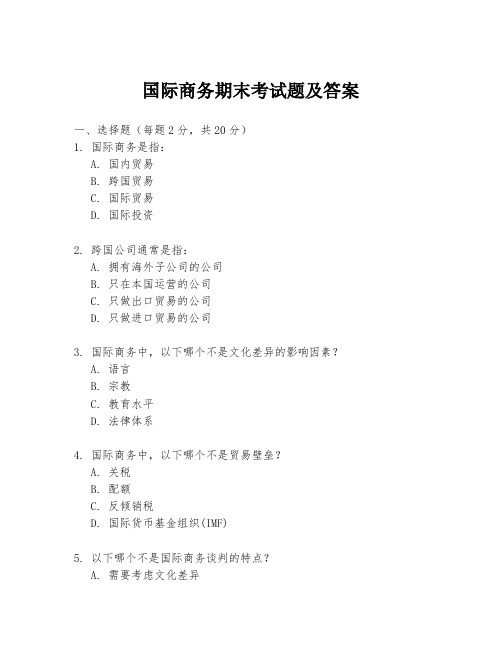
国际商务期末考试题及答案一、选择题(每题2分,共20分)1. 国际商务是指:A. 国内贸易B. 跨国贸易C. 国际贸易D. 国际投资2. 跨国公司通常是指:A. 拥有海外子公司的公司B. 只在本国运营的公司C. 只做出口贸易的公司D. 只做进口贸易的公司3. 国际商务中,以下哪个不是文化差异的影响因素?A. 语言B. 宗教C. 教育水平D. 法律体系4. 国际商务中,以下哪个不是贸易壁垒?A. 关税B. 配额C. 反倾销税D. 国际货币基金组织(IMF)5. 以下哪个不是国际商务谈判的特点?A. 需要考虑文化差异B. 需要考虑法律法规C. 只关注价格因素D. 需要考虑政治风险6. 国际商务中,以下哪个不是风险管理的策略?A. 风险规避B. 风险转移C. 风险接受D. 风险增加7. 国际商务中,以下哪个不是市场进入策略?A. 出口B. 合资C. 独资D. 进口8. 国际商务中,以下哪个不是国际支付方式?A. 信用证B. 汇票C. 支票D. 现金交易9. 国际商务中,以下哪个不是国际物流的特点?A. 跨国性B. 复杂性C. 单一性D. 时效性10. 国际商务中,以下哪个不是国际市场营销的策略?A. 产品策略B. 价格策略C. 渠道策略D. 质量策略二、简答题(每题10分,共30分)1. 简述国际商务与国内商务的主要区别。
2. 描述国际商务谈判中文化差异对谈判的影响。
3. 解释什么是国际市场营销的4P策略。
三、案例分析题(每题25分,共50分)1. 假设你是一家跨国公司的市场部经理,公司计划进入一个新的国际市场。
请分析并提出你的市场进入策略,并解释你的选择。
2. 某国际公司在海外运营时遇到了当地政府的贸易壁垒,导致产品无法顺利进入市场。
请分析可能的解决方案,并提出你的建议。
国际商务期末考试答案一、选择题1. C2. A3. C4. D5. C6. D7. D8. D9. C10. D二、简答题1. 国际商务与国内商务的主要区别在于国际商务涉及跨国界,需要考虑不同国家的法律法规、文化差异、政治风险以及汇率变动等因素。
国际商务期末考试题

国际商务练习题一、单选题1.(A)是指缔约一方现在和将来所给予任何第三方的一切特权、优待、利益及豁免,也同样给予缔约对方。
(1).最惠国待遇(2).国民待遇(3).市场经济地位(4).战略伙伴2(B)是指缔约一方保证缔约另一方的公民、企业和船舶在本国境内享受与本国公民、企业和船舶同等的待遇。
(1).最惠国待遇(2).国民待遇(3).市场经济地位(4).战略伙伴3在下列商业活动中,哪一笔属于国际商务活动(B)。
(1),美国花旗银行上海浦东分行向美国花旗银行总行贷款(2),美国花旗银行上海浦东分行向中国建设银行浦东分行贷款(3),美国花旗银行上海浦东分行向美国城市银行上海浦东分行贷款(4),美国花旗银行上海浦东分行向美国第一国民银行总行贷款4(B)是企业所特有的、能够经得起时间考验的、具有延展性,并且是竞争对手难以模仿的技术或能力。
(1).竞争力(2).核心竞争力(3).国际竞争力(4).表层竞争力5.企业通过自身要素的优化及与外部环境的交互作用,在有限的市场资源配置中占有相对优势,进而处于良性循环的可持续发展状态的能力( A )(1).竞争力(2).核心竞争力(3).国际竞争力(4).表层竞争力6.(C )是竞争力资产与竞争力国际化过程的统一。
(1).竞争力(2).核心竞争力(3).国际竞争力(4).表层竞争力7.企业通过一系列具体的策略和措施,使本企业成本与同行业其他企业成本相比很低的战略叫(C)(1).差异化战略(2).集中战略(3). 成本领先战略(4).低价倾销战略8企业采取一种集中的、为一组特定用户服务的战略是( B )A. A.差异化战略(2).集中战略(3). 成本领先战略(4).低价倾销战略9.一些企业拥有或可以得到的那些外国企业不能获得的优势,如产品、技术、规模经济、市场等称之为(A)(1).所有权优势(2).区位优势(3).内部化优势(4).成本优势10某中国小家电企业,总资产50亿元,年销售额20亿元,雇员总数4万人;其中,国外资产5亿元,国外销售额4亿元,国外雇员2千人,该企业跨国化指数为( D)(1).10% (2).20% (3).5% (4).11.7%11. 在其他国家境内的本国律师事务所、银行分支机构提供的服务属于服务贸易中的(D)(1). 境外消费(2). 跨境提供(3). 自然人流动(4). 商业存在12.企业通过各种不同的方式,进口原料、材料或零件,利用本国的生产能力和技术,加工成成品后再出口,从而获得以外汇体现的附加价值,这一国际化方式称(C )(1).一般贸易(2).技术贸易(3).加工贸易(4).国际特许经营13某公司为东道国建造工厂或其他工程项目,一旦设计与建造工程完成,即将该工厂或项目所有权和管理权依合同完整地给对方,这一国际化方式称(D )。
2017年国际商务单证员考试题及答案解析

2017年国际商务单证员考试题及答案解析2017年国际商务单证员考试题及答案解析1.班轮提单的作用是什么?A。
物权凭证B。
承运人签发给托运人的货物收据C。
承运人与托运人之间运输契约的证明D。
出口人纳税的依据2.联运提单与国际多式联运提单在性质上有什么区别?A。
使用的范围不同B。
承运人不同C。
承运人对运输负责的范围不同D。
前者为物权凭证,后者不一定3.根据《UCP600》的解释,信用证的规定是什么?A。
未规定是否保兑,即为保兑信用证B。
未规定是否保兑,即为不保兑信用证C。
未规定可否转让,即为可转让信用证D。
未规定可否转让,即为不可转让信用证4.当买方不愿承担装货费用时,买方采用FOB条件进口散装小麦,采用租船运输,可选用以下哪个价格术语变形?A。
FOB TrimmedB。
FOB Under TackleC。
FOB Liner TermsD。
FOB Stowed5.出境货物报检时需提交哪些单证?A。
汇票B。
C。
合同D。
包装性能结果单6.共同海损分摊时,涉及的受益方包括哪些?A。
船方B。
救助方C。
货方D。
运费方7.我国对外贸易中采用的合同形式主要有哪些?A。
销售合同B。
口头约定C。
售货确认书D。
订单8.对于保兑信用证,承担第一性付款责任的银行是哪个?A。
通知行B。
开证行C。
议付行D。
保兑行9.集装箱海运出口托运时,关于场站收据,下列哪个说法是正确的?A。
是堆场或货运站收货的凭证B。
是划分承、托双方责任的重要依据C。
是发货人凭以换取提单的唯一凭证D。
是承运人通知装运船舶接货装船的命令10.因租船订舱所需要的单据有哪些?A。
托运单B。
装货单C。
装箱单D。
海运提单11.根据《UCP600》的解释,开证行可以拒付货款的理由是什么?A。
单证不符B。
开证申请人破产C。
单单不符D。
单据与货物不符12.如果信用证中没有特别规定,原产地证书可以由哪个机构出具?A。
商检局B。
贸促会C。
生产企业D。
出口企业13.哪些条款应被视为信用证的“软条款”?A。
国际商务管理期末考试试题及答案

国际商务管理期末考试试题及答案一、选择题(每题2分,共20分)1. 国际商务管理的核心目标是:A. 利润最大化B. 市场份额最大化C. 客户满意度最大化D. 企业社会责任答案:A2. 跨国公司在进行国际扩张时,通常采用的组织结构是:A. 功能型结构B. 地理型结构C. 产品型结构D. 矩阵型结构答案:B3. 国际贸易理论中,比较优势理论的提出者是:A. 亚当·斯密B. 大卫·李嘉图C. 约翰·梅纳德·凯恩斯D. 弗里德里希·李斯特答案:B4. 在国际市场进入策略中,合资企业属于哪种类型?A. 出口B. 许可C. 特许经营D. 直接投资答案:D5. 国际商务谈判中,文化差异可能导致:A. 沟通障碍B. 价格谈判困难C. 法律风险D. 物流问题答案:A...(此处省略其他选择题)二、简答题(每题10分,共30分)1. 简述国际商务中的文化适应性对企业成功的重要性。
答案:国际商务中的文化适应性对企业成功至关重要。
企业需要了解并尊重目标市场的文化差异,包括商业习惯、沟通方式、价值观念等。
这有助于建立良好的客户关系,避免文化冲突,提高谈判成功率,并促进品牌在国际市场的接受度。
2. 描述国际市场营销中的4Ps策略。
答案:国际市场营销中的4Ps策略是指产品(Product)、价格(Price)、地点(Place)和促销(Promotion)。
企业需要根据国际市场的特定需求和偏好调整产品特性;制定合理的价格策略以吸引消费者;选择合适的分销渠道以确保产品的可得性;以及设计有效的促销活动以提高品牌知名度和市场占有率。
3. 解释什么是国际商务中的“全球战略”。
答案:国际商务中的“全球战略”是指企业在全球范围内统一其业务运作,以实现规模经济和效率最大化。
这种战略强调全球一体化,通过集中资源、标准化产品和流程,以及利用全球供应链来降低成本,提高竞争力。
三、案例分析题(每题25分,共50分)1. 假设你是一家国际服装品牌的市场经理,你的品牌计划进入一个新的亚洲市场。
(完整版)《国际商务》
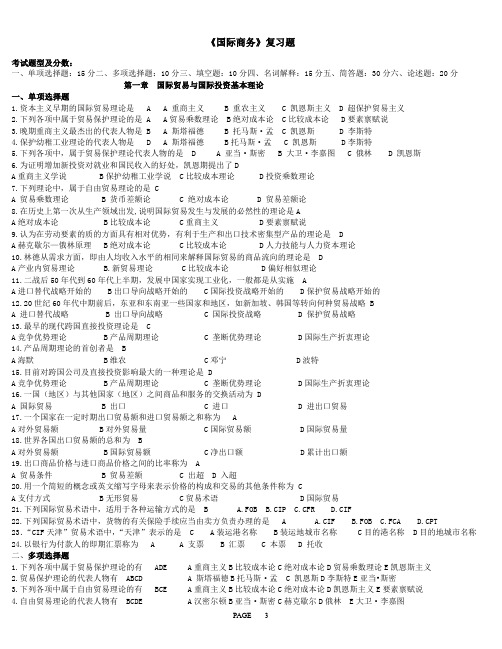
《国际商务》复习题考试题型及分数:一、单项选择题:15分二、多项选择题:10分三、填空题:10分四、名词解释:15分五、简答题:30分六、论述题:20分第一章国际贸易与国际投资基本理论一、单项选择题1.资本主义早期的国际贸易理论是 A A 重商主义 B 重农主义 C 凯恩斯主义 D 超保护贸易主义2.下列各项中属于贸易保护理论的是 A A贸易乘数理论 B绝对成本论 C比较成本论 D要素禀赋说3.晚期重商主义最杰出的代表人物是 B A 斯塔福德 B 托马斯·孟 C 凯恩斯 D 李斯特4.保护幼稚工业理论的代表人物是 D A 斯塔福德 B托马斯·孟 C 凯恩斯 D李斯特5.下列各项中,属于贸易保护理论代表人物的是 D A 亚当·斯密 B 大卫·李嘉图 C 俄林 D 凯恩斯6.为证明增加新投资对就业和国民收入的好处,凯恩期提出了DA重商主义学说 B保护幼稚工业学说 C比较成本理论 D投资乘数理论7.下列理论中,属于自由贸易理论的是 CA 贸易乘数理论B 货币差额论C 绝对成本论D 贸易差额论8.在历史上第一次从生产领域出发,说明国际贸易发生与发展的必然性的理论是AA绝对成本论 B比较成本论 C重商主义 D要素禀赋说9.认为在劳动要素的质的方面具有相对优势,有利于生产和出口技术密集型产品的理论是 DA赫克歇尔—俄林原理 B绝对成本论 C比较成本论 D人力技能与人力资本理论10.林德从需求方面,即由人均收入水平的相同来解释国际贸易的商品流向的理论是 DA产业内贸易理论 B.新贸易理论 C比较成本论 D偏好相似理论11.二战后50年代到60年代上半期,发展中国家实现工业化,一般都是从实施 AA进口替代战略开始的B出口导向战略开始的 C国际投资战略开始的D保护贸易战略开始的12.20世纪60年代中期前后,东亚和东南亚一些国家和地区,如新加坡、韩国等转向何种贸易战略 BA 进口替代战略B 出口导向战略C 国际投资战略D 保护贸易战略13.最早的现代跨国直接投资理论是 CA竞争优势理论 B产品周期理论 C 垄断优势理论 D国际生产折衷理论14.产品周期理论的首创者是 BA海默 B维农 C邓宁 D波特15.目前对跨国公司及直接投资影响最大的一种理论是 DA竞争优势理论 B产品周期理论 C 垄断优势理论 D国际生产折衷理论16.一国(地区)与其他国家(地区)之间商品和服务的交换活动为 DA 国际贸易B 出口C 进口D 进出口贸易17.一个国家在一定时期出口贸易额和进口贸易额之和称为 AA对外贸易额 B对外贸易量 C国际贸易额 D国际贸易量18.世界各国出口贸易额的总和为 BA对外贸易额B国际贸易额 C净出口额 D累计出口额19.出口商品价格与进口商品价格之间的比率称为 AA 贸易条件B 贸易差额C 出超D 入超20.用一个简短的概念或英文缩写字母来表示价格的构成和交易的其他条件称为 CA支付方式 B无形贸易 C贸易术语 D国际贸易21.下列国际贸易术语中,适用于各种运输方式的是 B A.FOB B.CIP C.CFR D.CIF22.下列国际贸易术语中,货物的有关保险手续应当由卖方负责办理的是 A A.CIF B.FOB C.FCA D.CPT 23.“CIF天津”贸易术语中,“天津”表示的是 C A装运港名称B装运地城市名称 C目的港名称 D目的地城市名称24.以银行为付款人的即期汇票称为 A A 支票 B 汇票 C 本票 D 托收二、多项选择题1.下列各项中属于贸易保护理论的有 ADE A重商主义B比较成本论C绝对成本论D贸易乘数理论E凯恩斯主义2.贸易保护理论的代表人物有 ABCD A 斯塔福德B托马斯·孟 C 凯恩斯D李斯特E亚当•斯密3.下列各项中属于自由贸易理论的有 BCE A重商主义B比较成本论C绝对成本论D凯恩斯主义E要素禀赋说4.自由贸易理论的代表人物有 BCDE A汉密尔顿B亚当·斯密C赫克歇尔D俄林 E大卫·李嘉图5.根据国际生产折衷理论,影响企业从事对外直接投资的变量有 ABD A内部化优势 B所有权优势C资源优势D 区位优势E政策优势6.当出口贸易额大于进口贸易额时,可称之为 ADE A贸易顺差B贸易逆差C贸易赤字D贸易盈余E出超7.当出口贸易额小于进口贸易额时,可称之为 BCE A贸易顺差B贸易逆差C贸易赤字D出超E入超8.下列国际贸易术语中,仅适用于水上运输方式的是 ABC A FOB B CFR C CIF D FCA E CPT9.下列国际贸易术语中,适用于各种运输方式的是 ADE A CIP B CFR C CIF D FCA E CPT10.下列国际贸易术语中,货物的风险在船舷转移的是 ABE A FOB B CFR C CIP D FCA E CIF三、填空题1.贸易保护的起点是(重商主义)。
国际商务谈判真题201704含答案
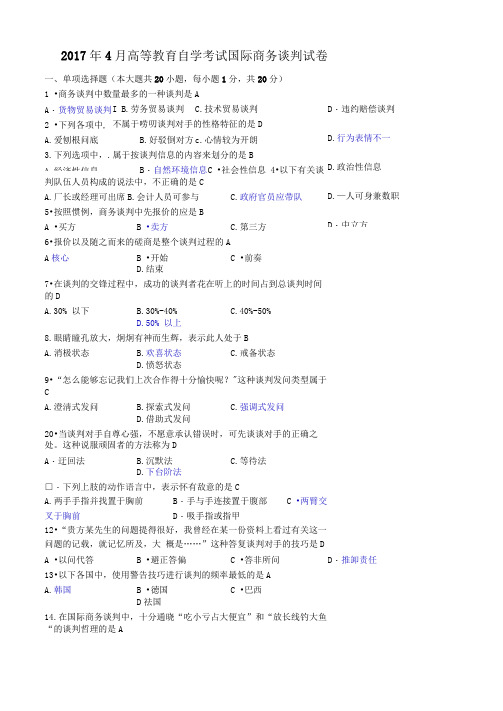
2017年4月高等教育自学考试国际商务谈判试卷一、单项选择题(本大题共20小题,每小题1分,共20分)1 •商务谈判中数量最多的一种谈判是AI B.劳务贸易谈判 C.技术贸易谈判 不属于唠叨谈判对手的性格特征的是DB.好驳倒对方 c.心情较为开朗 属于按谈判信息的内容来划分的是B B ・自然环境信息 C •社会性信息 4•以下有关谈判队伍人员构成的说法中,不正确的是CA.厂长或经理可出席B.会计人员可参与C.政府官员应带队 5•按照惯例,商务谈判中先报价的应是BA •买方B •卖方 C.第三方 6•报价以及随之而来的磋商是整个谈判过程的A A 核心B •开始C •前奏 D.结束 7•在谈判的交锋过程中,成功的谈判者花在听上的时间占到总谈判时间的DA.30% 以下B.30%-40%C.40%-50%D.50% 以上 8.眼睛瞳孔放大,炯炯有神而生辉,表示此人处于B A.消极状态B.欢喜状态C.戒备状态D.愤怒状态 9•“怎么能够忘记我们上次合作得十分愉快呢?"这种谈判发问类型属于CA.澄淸式发问B.探索式发问C.强调式发问D.借助式发问 20•当谈判对手自尊心强,不愿意承认错误时,可先谈谈对手的正确之处。
这种说服顽固者的方法称为DA ・迂回法B.沉默法C.等待法D.下台阶法 □・下列上肢的动作语言中,表示怀有敌意的是CA.两手手指并找置于胸前B ・手与手连接置于腹部C •两臂交叉于胸前 D ・吸手指或指甲 12•“贵方某先生的问题提得很好,我曾经在某一份资料上看过有关这一问题的记载,就记忆所及,大 概是……”这种答复谈判对手的技巧是DA •以问代答B •避正答偏C •答非所问 13•以下各国中,使用警告技巧进行谈判的频率最低的是AA.韩国B •徳国C •巴西D 祛国 14.在国际商务谈判中,十分通晓“吃小亏占大便宜”和“放长线钓大鱼“的谈判哲理的是AA ・货物贸易谈判2 •下列各项中, A.爱刨根问底 3.下列选项中,.A.经济性信息D ・违约赔偿谈判D.行为表情不一D.政治性信息 D.—人可身兼数职 D ・中立方 D ・推卸责任A・日本人B・美国人C・英国人15•在谈判方案上喜欢搞全盘平衡的“一揽子交易”的是BA.中国人B.美国人C.韩国人16.在商业交往中,习惯使用"IBM"的谈判者是CA.犹太人B.大洋洲人C.阿拉伯人27・下列选项中,不属于合同风险的是DA •交货风险B •质量风险C•数量风险D・会计风险28•下列选项中,不属于使外汇风险消失的对策是C D.法国人D.徳国人D価班牙人A •单项平衡法B •综合平衡法19.以下各项中,不属于银行担保的是A A・财产保险 B.履约保证书C,期权交易法 D.人民币计价法C •预付款担保 D •投标保证书20 •开拓海外市场既可能成功也可能失败。
(完整版)国际商务管理2017秋季学期期末考试答案
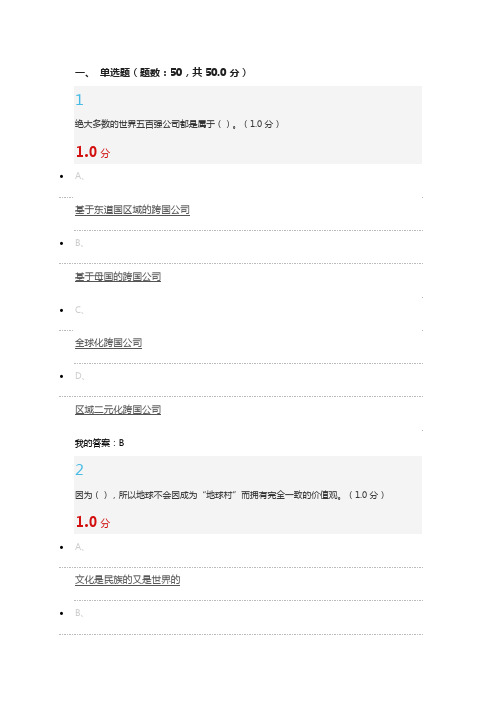
1.0分我的答案:√3内部化理论认为,企业是在完全竞争的市场中运行的。
()(1.0分)1.0分我的答案:×4欧洲美元市场是亚洲美元市场的延伸。
()(1.0分)1.0分我的答案:×5公司要不断地加强和补充核心竞争力,并将其作为日后发展和出售一系列最终产品的途径。
()(1.0分)1.0分我的答案:√6对外直接投资形成的物质基础是跨国公司。
()(1.0分)1.0分我的答案:√7跨国公司的迅速发展导致了生产和资本的国际化。
()(1.0分)1.0分我的答案:×8关贸总协定与世界贸易组织都具有法人(机构)地位。
()(1.0分)1.0分我的答案:×9文化渗透是个需要长时间观察,但培育的过程并不耗时。
()(1.0分)1.0分我的答案:×10对企业有利的利益不一定对国家有利。
()(1.0分)1.0分我的答案:√11截至2012年,LDC国家占据了全球手机90%以上的新增用户份额。
()。
(1.0分)1.0分我的答案:×12在上海设立总部的跨国公司,其母公司资产总额不得低于4亿美元。
()(1.0分)1.0分我的答案:√13中国企业在国际化发展中,市场资金充裕,相对融资成本较低。
()(1.0分)1.0分我的答案:√14企业的战略资产就是企业的核心能力。
()(1.0分)1.0分我的答案:×15当代很多政府本质上已经摆脱了重商主义的束缚。
()(1.0分)1.0分我的答案:×16当进口额大于出口额时,被称为贸易盈余。
()(1.0分)1.0分我的答案:×17国际货币基金组织是世界上最大的多变贸易组织。
()(1.0分)1.0分我的答案:×18企业的制度是一成不变的,不会发生转型。
()(1.0分)我的答案:×19要素、市场和产品是国外目标市场的三大类因素。
()(1.0分)1.0分我的答案:×20全局性是企业战略管理最根本的特性。
- 1、下载文档前请自行甄别文档内容的完整性,平台不提供额外的编辑、内容补充、找答案等附加服务。
- 2、"仅部分预览"的文档,不可在线预览部分如存在完整性等问题,可反馈申请退款(可完整预览的文档不适用该条件!)。
- 3、如文档侵犯您的权益,请联系客服反馈,我们会尽快为您处理(人工客服工作时间:9:00-18:30)。
国际商务练习题一、单选题1.(A)是指缔约一方现在和将来所给予任何第三方的一切特权、优待、利益及豁免,也同样给予缔约对方。
(1).最惠国待遇(2).国民待遇(3).市场经济地位(4).战略伙伴2(B)是指缔约一方保证缔约另一方的公民、企业和船舶在本国境内享受与本国公民、企业和船舶同等的待遇。
(1).最惠国待遇(2).国民待遇(3).市场经济地位(4).战略伙伴3在下列商业活动中,哪一笔属于国际商务活动(B)。
(1),美国花旗银行上海浦东分行向美国花旗银行总行贷款(2),美国花旗银行上海浦东分行向中国建设银行浦东分行贷款(3),美国花旗银行上海浦东分行向美国城市银行上海浦东分行贷款(4),美国花旗银行上海浦东分行向美国第一国民银行总行贷款4(B)是企业所特有的、能够经得起时间考验的、具有延展性,并且是竞争对手难以模仿的技术或能力。
(1).竞争力(2).核心竞争力(3).国际竞争力(4).表层竞争力5.企业通过自身要素的优化及与外部环境的交互作用,在有限的市场资源配置中占有相对优势,进而处于良性循环的可持续发展状态的能力( A )(1).竞争力(2).核心竞争力(3).国际竞争力(4).表层竞争力6.(C )是竞争力资产与竞争力国际化过程的统一。
(1).竞争力(2).核心竞争力(3).国际竞争力(4).表层竞争力7.企业通过一系列具体的策略和措施,使本企业成本与同行业其他企业成本相比很低的战略叫(C)(1).差异化战略(2).集中战略(3). 成本领先战略(4).低价倾销战略8企业采取一种集中的、为一组特定用户服务的战略是( B )A. A.差异化战略(2).集中战略(3). 成本领先战略(4).低价倾销战略9.一些企业拥有或可以得到的那些外国企业不能获得的优势,如产品、技术、规模经济、市场等称之为(A)(1).所有权优势(2).区位优势(3).内部化优势(4).成本优势10某中国小家电企业,总资产50亿元,年销售额20亿元,雇员总数4万人;其中,国外资产5亿元,国外销售额4亿元,国外雇员2千人,该企业跨国化指数为( D)(1).10% (2).20% (3).5% (4).11.7%11. 在其他国家境内的本国律师事务所、银行分支机构提供的服务属于服务贸易中的(D)(1). 境外消费(2). 跨境提供(3). 自然人流动(4). 商业存在12.企业通过各种不同的方式,进口原料、材料或零件,利用本国的生产能力和技术,加工成成品后再出口,从而获得以外汇体现的附加价值,这一国际化方式称(C )(1).一般贸易(2).技术贸易(3).加工贸易(4).国际特许经营13某公司为东道国建造工厂或其他工程项目,一旦设计与建造工程完成,即将该工厂或项目所有权和管理权依合同完整地给对方,这一国际化方式称(D )。
(1).国际特许经方式(2).许可证方式(3).新建直接投资(4).交钥匙工程14.麦当劳在中国开设连锁店属于( A)(1).国际特许经营方式(2).许可证方式(3).新建直接投资(4).交钥匙工程15.根据消费者对产品的需求欲望、购买行为与购买习惯的差异,把整个国际市场划分为两个或更多的消费者群,从而确定国际目标市场的活动过程是( B )(1).国际市场定位(2).国际市场细分(3).国际目标市场选择(4).国际市场评估16.宝洁公司将牙膏细分为价廉物美、防治牙病、洁齿美容、口味清爽四个市场,该细分市场的依据是(C)。
(1).地理B.人口(3).心理(4).行为17.(A)是指企业把整个国际市场看作一个大的单一目标市场,认为市场上所有消费者对本企业产品的需求都不存在差异性。
(1). 无差异市场策略(2). 差异性市场策略(3).市场定位策略(4). 集中性营销策略18.(B)是指企业同时经营几个细分市场,并为每个细分市场设计不同的产品。
(1). 无差异市场策略(2). 差异性市场策略(3).市场定位策略(4). 集中性营销策略19.将自己的产品定位在目标市场上尚未得到满足的那部分需求的策略是(A)(1).市场空隙策略(2).追随市场领先者策略(3).市场挑战者策略(4).差异化策略20.我国曾向伊朗出口10万辆自行车,由于在车座所用皮革上没有注意伊斯兰教的特殊要求,受到伊朗进口商的刁难。
这提醒我们在跨国经营活动中应重视其他民族的( B )。
(1),生活习惯(2),宗教信仰(3),体态语言差异(4),文字语言差异21.在一般巴西人的观念中,紫色表示悲哀,因而有紫色饰带的日本钟表会受到巴西人的冷落,这反映了巴西人独特的(A)。
(1),审美观念(2),质量观念(3),消费观念(4),时间观念22.生活节奏最快,最注意准时的是()。
(1),中国人(2),印度人(3),印尼人(4),新加坡人23.以下国家中,时间观念最差的国家是()。
(1),美国(2),意大利(3),英国(4),巴西24.世界上信徒最多的三大宗教是()。
(1),印度教、儒教、犹太教(2),基督教、伊斯兰教、佛教(3),基督教、伊斯兰教、印度教(4),基督教、印度教、佛教25.伊斯兰教的信徒禁止(A)。
(1),喝酒(2),喝咖啡(3),吸烟(4),喝葡萄汁26.在国际经营活动中,正确运用语言是十分重要的。
对经营活动中所涉及的函电、合同、商品牌名、产品说明、广告等,可将其视作为()。
(1),口头语言(2),文字语言(3),体态语言(4),人体语言27.当公司直接卷入在国外的采购或推销,或在海外直接制造产品和提供劳务,并且在海外有自己的长期派驻人员时,在公司的组织中,可能有一个“国际部”而不只是一个国际“科”,此时,该公司的发展处于()。
(1),国际化的第一阶段(2),国际化的第二阶段(3),国际化的第三阶段(4),国际化的第四阶段28.最基本的企业营销组合 4P 是指()(1). 产品、价格、计划、促销(2). 产品、价格、计划、请求(3). 产品、价格、渠道、促销(4). 产品、价格、计划、渠道29.明星产品指具有高市场增长率和()的业务。
(1),高市场占有率(2),高收益率(3),高回报率(4),高风险30((1))如不能向金牛产品发展,应果断淘汰,继续维持只会加重企业的负担。
(1).瘦狗产品(2).明星产品(3).问题产品(4).新产品31.如果一家公司试图在所有东道国(),那它就会在低薪国家因成本高在市场上站不住脚,而在高薪国家又招聘不到合格的管理人员。
(1),实施差别工资(2),使用严格等级制工资(3),工资递增制度(4),保持同一工资水平32市场比较集中、渠道短、销售力量强及产品需经过示范、退换的商品,一般使用()(1).广告推销(2).人员推销(3).营业推广(4)。
公共关系33.国际直接分销渠道不经过任何()。
(1),制造商(2),消费者(3),最终用户(4),中间商34()是指销售渠道中的每个层次使用同类中间商数目的多少。
(1),渠道长度(2),产品线长度(3),产品线宽度(4),渠道宽度35.本国派出的经理应熟悉母公司的情况,熟悉母公司的政策、习惯做法及人事状况等,因此西方跨国公司中较为常见的做法是()。
(1),高层管理人员本土化(2),高层管理人员国际化(3),高层管理人员区域化(4),高层管理人员母国化36.一个组织、经济实体或个人的以外币计价的资产(债权、权益)与负债(债务、义务),因外汇汇率波动而引起的价值上涨或下降的可能,称为()(1).资产风险(2).债务风险(3).财务风险(4).外汇风险37.以外国货币定值或计价的合同,在汇率变动后进行收付结算时其本币价值发生增减变化的可能性,称为()。
(1).交易风险(2).折算风险(3).经济风险(4).财务风险38.()有时也被称为会计风险,产生于国际企业将其国外附属公司或投资经营项目成果的计值单位由记账外币换算成本币的换算过程。
(1). 交易风险(2).经济风险(3). 折算风险(4).投资风险二、多选题1.国际商务和国内商务的区别主要表现在( BCD)(1)本质属性不同(2)发展环境不同(3)活动方式不同(4)管理因素与方式不同2.当代跨国公司的发展趋势是(ABCD)(1)实行本地化经营,塑造当地化概念(2)越来越重视高新技术发展;注重信息化管理(3)对发展中国家愈来愈重视(4)跨国并购日趋剧烈3.当代跨国公司的主要特征( ABC)(1)生产经营活动的跨国化(2)经营战略全球化(3)公司内部一体化(4)经营领域单一化4.((1)(2)(3))是当代最重要的国际经济组织(ABC)(1).WTO (2). IMF (3).WB (4).APEC5.将竞争参与者类型和竞争参与方式结合起来,国际竞争的主要类型包括( ABC )(1).全球市场竞争(2).多国市场竞争(3).大宗贸易市场竞争(4).纯国内市场竞争6.跨国公司使用成本领先战略适用条件包括( BCD )(1).现有竞争企业之间的价格竞争非常激烈;(2).企业所处产业的产品基本上是标准化或者同质化的;(3).实现产品差异化的途径很少;(4).多数顾客使用产品的方式相同;7.跨国公司使用差异化战略适用条件包括(ABC)(1)可以有很多途径创造企业与竞争对手产品之间的差异,并且这种差异被顾客认为是有价值的;(2)顾客对产品的需求和使用要求是多种多样的,即顾客需求是有差异的;(3).采用类似差异化途径的竞争对手很少,即真正能够保证企业是“差异化”的;(4).技术变革很快,市场上的竞争主要集中在不断地推出新的产品特色。
8.东道国民族企业在以下哪些方面较其他国家的跨国企业具有优势(ABC)(1).民族企业更能适应本国政治、经济、法律及文化等诸因素所组成的投资环境(2).民族企业常得到本国政府的优惠和保护(3).民族企业不必担负跨国经营企业所无法逃避的各种费用和风险(4).民族企业生产或服务效率更高9.国际生产折衷理论提出决定一国企业对外直接投资的变量包括(ABD )(1).所有权优势(2).内部化优势。
